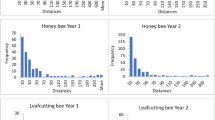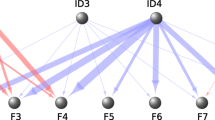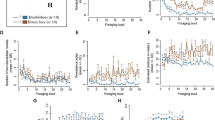Summary
The aims of this paper were to consider the coevolution between bumblebee movement patterns within plants and various properties of the plants such as the spatial distribution of their flowers, and to determine the extent to which the bumblebees and the plants can be considered to be maximally adaptive or optimal. Attention was restricted to plants which have flowers arranged on vertical inflorescences and to the bumblebees which visit these plants.
It was found that the bumblebees tend to commence foraging at the bottom of each infloresence, that they tend to move from one flower to the closest vertically higher flower, that they miss flowers as they move upwards and that they tend to leave each inflorescence before reaching the top. It was also found for the four common plant species considered that nectar abundance per flower decreases with flower height on an inflorescence, that the flowers with receptive stigmas are restricted to the bottoms of the inflorescences while the flowers shedding pollen occur above them, and that the flowers are arranged approximately in spirals on the inflorescences.
The pattern of movements of the bumblebees and the various properties of the plants appear to represent coevolved adaptations. Furthermore the bumblebees' movement patterns appear to be optimal in the sense that they result in the maximum net rate of energy gain to the bumblebees. Further studies are necessary, however, to determine whether or not the plants can be considered to be optimal.
An exception to the above scheme is provided by a plant which is quite uncommon in the study area. This plant also has flowers on vertical inflorescences and appears to be pollinated by bumblebees. However, while the pattern of movements of the bumblebees on this plant species are extremely similar to those on the four common species, this plant species exhibits quite different properties from the other four. Two possible explanations for this exception are presented.
Similar content being viewed by others

References
Benham, B.R.: Insect visitors to Chamaerion angustifolium and their behaviour in relation to pollination. Entomologist 102, 221–228 (1969)
Charnov, E.L.: Optimal foraging: the marginal value theorem. Theor. Pop. Biol. 9, 129–136 (1976)
Cruden, R.W.: Intraspecific variation in pollen-ovule ratios and nectar-secretion-preliminary evidence of ecotypic adaptation. Ann. Missouri Bot. Gard. 63, 277–289 (1976)
Epling, C., Lewis, H.: Increase of the adaptive tange of the genus Delphinium. Evol. 6, 253–267 (1952)
Faegri, K., van der Pijl, L.: The principles of pollination ecology, 2nd revised ed. Oxford: Pergamon Press 1971
Heinrich, B.: Energetics of pollination. Ann. Rev. Ecol. Syst. 6, 139–170 (1975)
Hocking, B.: Insect-flower associations in the high artic with special reference to nectar. Oikos 19, 359–388 (1968)
Holling, C.S.: The analysis of complex population processes. Can. Entomol. 96, 335–347 (1964)
Kevan, P.G.: Insect-flower associations in the high Arctic with special reference to nectar. J. Ecol. 60, 831–847 (1972)
Leigh, E.G.: The perfection of sponges. In: Adaptation and diversity, Chapter 2. Freeman 1971
Macior, L.W.: Pollination adaptation in Pedicularis lanceolata. Amer. J. Bot. 56, 853–859 (1969)
McFarland, D.J., Sibly, R.M.: The behavioural final common path. Phil. Trans. Roy. Soc. Lond. B. 270, 265–293 (1975)
Müller, H.: The fertilization of flowers (translated by D'Arcy W. Thompson). London: London Press 1883
Percival, M.S.: Floral biology. Oxford: Pergamon Press 1965
Pyke, G.H.: Studies in the foraging efficiency of animals. Ph. D. Thesis, University of Chicago (1974)
Pyke, G.H.: Optimal foraging in bumblebees: Pattern of movements between inflorescences. Theor. Pop. Biol. 13, 72–98 (1978)
Pyke, G.H., Pulliam, H.R., Charnov, E.L.: Optimal foraging: A selective review of theory and tests. Quart. Rev. Biol. 52, 137–154 (1977)
Schoener, T.W.: Theory of feeding strategies. Ann. Rev. Ecol. Syst. 2, 369–404 (1971)
Stearns, S.C.: Life history tactics: A review of the ideas. Quart. Rev. Biol. 51, 3–47 (1976)
Author information
Authors and Affiliations
Rights and permissions
About this article
Cite this article
Pyke, G.H. Optimal foraging in bumblebees and coevolution with their plants. Oecologia 36, 281–293 (1978). https://doi.org/10.1007/BF00348054
Received:
Issue Date:
DOI: https://doi.org/10.1007/BF00348054



